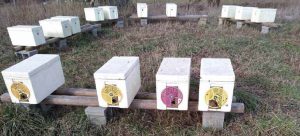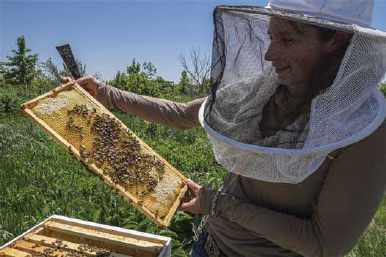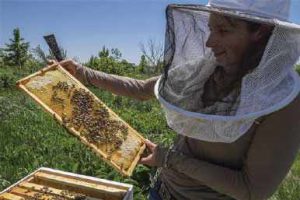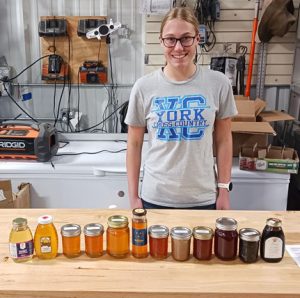By : Meghan Milbrath
I used to keep a small flock of sheep, and I would go through a lot of hay. One day when I was buying hay from a neighbor, a truck pulled up to buy a load of hay to take to Texas. That same week, our other neighbor purchased hay from Minnesota at auction. In Michigan, even though we have plenty of hay in our state, we sometimes ship our hay to Texas and buy it from Minnesota. Largescale commodity farmers can find themselves in these absurd and seemingly inefficient distribution cycles, because wholesale buyers are chained to big contracts and national pricing. On a small-scale, however, this practice of shipping the same product into and out of the same area seems absurdly wasteful. As a small-scale farmer, I didn’t need to be tied to the national hay market, and I could purchase all of my hay locally. Similarly, as a small-scale beekeeper, I shouldn’t have to be tied into the national market. Commercial bees need to travel around the country to provide pollination services so we can have fruits and vegetables. These commercial beekeepers need a model that maximizes economies, so they can have sustainable businesses. Small-scale and hobby beekeepers, on the other hand, have absolutely no reason to participate in this cross-country movement of bees, and should be able to source their bees locally.
Many people get into beekeeping as they strive towards a more sustainable lifestyle; we garden, plant for pollinators, buy local food, and focus on living with less impact. However, when it comes to beekeeping, it seems these values of sustainability fly right out the front entrance. Many small-scale beekeeping operations are completely unsustainable, with high levels of bee death, high costs, and high environmental impact. Even worse, unstainable practices have become completely normalized in hobby beekeeping. It is normal and completely acceptable to have high losses, year after year, and replace your bees in the Spring with nucs and packages from across the country. Truckloads of bees arrive each Spring, trying to fill an almost insatiable demand of hobby and small-scale beekeepers replacing lost hives. Think of the carbon footprint of this event – trucks crisscrossing the entire country to make sure that every local bee club can fulfill their bulk orders of replacement bees. What would happen if hobby and small-scale beekeepers separated themselves from this national exchange and focused on what was available locally? If small-scale beekeepers could no longer buy bees from out of state, we wouldn’t run out of bees. Instead, we would be motivated to make the most of the bees that we already have. We would become more sustainable, and we would be forced to be better beekeepers.
Take a moment to ask yourself if the way you keep bees lines up with your values. Are you comfortable in your role in transporting bees across the country? Does it feel like the way you keep bees is good for bees in your area? Are you helping the local community of beekeepers?
If your beekeeping is not in line with your values of animal welfare, economic sustainability, and a smaller carbon footprint, it may be time to retool and rethink your strategy.
Here is my definition of a sustainable apiary:
– My bees are kept in good health and free from preventable illness, so my losses are minimized;
– I anticipate my losses and prepare for them, so I don’t have replacement costs;
– My excess bees are made available to beekeepers in my local community.
Every beekeeper has the capacity to make bees available to their neighbor, because bees naturally produce more bees. Every colony that comes through the winter strong can produce (minimally) one split that can be made available to local beekeepers. Unless you are perpetually expanding, you have excess local bees that could support local beekeepers. I have literally heard a beekeeper say that they didn’t want to split their hive because they didn’t want more bees. They let the colony swarm, losing the bees to the trees, and their neighbor beekeeper had to purchase a package from out of state. How great would it have been if that beekeeper made a split of their hive for their neighbor instead?
I do sometimes get frustrated by how wasteful and unsustainable many small-scale beekeepers are with their bees, and how quick they are to purchase replacement packages, rather than use the bees that they have. However, as my great-uncle Charlies always said, “Any old ass can kick down a barn, but it takes a really special donkey to build a shed.” In other words, it is really easy to point out when people are doing something wrong, but it takes a lot more work to help think of a way to fix the solution. In 2015, I was awarded a small SARE farmer rancher grant to address this issue, and I have found a system that made my beekeeping much more sustainable, and more in line with my values. It involves three steps: 1) Accounting for (and being accountable for) my losses, 2) Making up replacement colonies from within my own apiary, and 3) Making my excess bees available to my local community. In this article I’ll cover step one, and over the next two months I’ll cover in detail the second two steps.
Accounting for losses
To make beekeeping more sustainable, we need to focus on two things: supply and demand. First, we need to reduce demand by getting a handle on our losses. Many smallscale beekeepers still suffer from incredibly high losses–many bee clubs report ridiculously high colony losses of 50-100% annually. (Sadly, this is another thing that has become normalized – you should not be okay with such high losses). If you are losing more than 15% of your colonies every year, you need to reevaluate your management strategy BEFORE you purchase more bees. Right now, the bee season is stretching before us, and we are ordering packages with the best intentions and high resolutions (This is going to be the year!). By July we go on vacations, have soccer practices, injuries, etc., and the care of our bees gets pushed aside. When we procrastinate on our feeding, Varroa treatments, and supering, our bees don’t survive. Rusty Burlew wrote a lovely article that should be required reading for beekeepers: https://honeybeesuite. com/overwintering-success-theone- thing-i-do-differently/. She has great success with her bees, and when asked what she does differently she states, “The thing I do differently is simple: I never procrastinate. If something needs to be done for my bees, I do it. And soon . . . Years ago a wizened old beekeeper told me that keeping bees doesn’t take much time, but the things that must be done, must be done on time. That simple idea became my beekeeping mantra, and I believe that ethic, more than anything else, has helped me to be successful.”
Most beekeepers lose their bees because they do not do the things that need to be done in time. The worst case is with controlling parasites, and beekeepers let Varroa mites build up to deadly levels in their hives. Timely intervention also applies to swarm control, feeding and supering. This year, the best thing that you can do for your bees is to honestly assess how many colonies you can care for well. If you know you have a busy Summer ahead, or you haven’t been able to keep up in years past, then skip a year, reduce the number of hives you’ll manage, or set up a plan to have help. Order your bees, and vow that you’ll actually do what needs to be done to give them the best chance of health and success; these lovely animals deserve your commitment to their care.

These nucs are ready to go into Winter. If I lose any hives this year, I won’t have to buy packages. I can put the bees from these nucs into the deadouts. Any ones that I don’t need can be sold to local beekeepers. A good rule of thumb is to have one nuc for each hive that you are overwintering.
While we strive to reduce our demand by reducing our losses, we can also be working on our supply. At minimum, we should be able to supply ourselves with our own replacements (in the best-case scenario, we also supply our community with locally available bees). Supplying your own replacements means that you make enough excess colonies to cover any losses you may have over winter. You don’t replace dead colonies with packages from across the country, you use the spare colonies you have made in anticipation of a winter loss.
The first step to controlling replacements is to be realistic about losses. If you have lost 30% of your colonies every year, you should not be surprised if you lose 30% of your colonies this year. No single beekeeper managing multiple apiaries in the U.S. has 100% success every year. Be prepared for what you can expect to find in the Spring. Let’s say you’re a beekeeper with 10 colonies and you want 10 next season. If you incur a 30% loss, you’ll have seven in the Spring, three less than desired. Many beekeepers in this situation will buy three more packages to get them back up to 10 hives. (Though replacing colonies this way is very wasteful, it is common; I get requests for these type of replacement colonies every year.) Another, more sustainable strategy would be to make up the losses by splitting your own colonies in the Spring. Even better, we can plan ahead, by making excess colonies the season before. In the Fall we overwinter extra nucleus colonies, so we know we have extra bees in the Spring. If I make a nuc from each of my 10 hives, I can overwinter 20 colonies. I can then take even a 50% loss and be at the number I want, without having to purchase bees. If I have better survival, I’ll have bees available to sell to members of my local club.
The possible profit from this approach is compelling. Consider your 20 colonies, made by splitting your original 10. Even after a 30% loss, you have 14. In my area, nucs sold for $150-$200 in 2018. If you want 10 colonies, sell the extra four at $175 each, a profit of $700. Even if you have a bad honey year, you have already brought in extra dollars.
Comparing the two systems for a beekeeper with 10 hives and an average 30% loss:
- Current system: Overwinter 10 colonies, lose three, purchase three replacement packages at $135 each = Loss of $405 / year.
- New system: Make late-season splits to overwinter 20 colonies. Lose six, replace those with colonies you’ve made and sell remaining four extra = Profit of $700 / year.
The balance difference for this beekeeper is over $1100 for just 10 colonies in just one year. For most small-scale beekeepers, that is more than enough to cover replacement equipment, feed, and medications and to have a small profit, even before considering honey. Beekeeping is no longer a money sink: spouses are happier, and the new fishing boat has become a possibility. For smallscale farmers, this balance difference of $100 / hive in the spring can completely change the profitability of their operation.
There are other benefits besides the saving money and lessening the environmental impact of your beekeeping. While producers selling packages and nucs do a good job of controlling disease (their business depends on it), colonies are not sterile. A nuc taken from even a healthy colony can carry pathogens than can cause disease. Cross-country transport is stressful on bees; queens and brood especially have health consequences from temperature changes, and quick shifts in climate. This stress often leads to stress related diseases – some that can plague your operation for years to come. The sooner you stop bringing in outside bees, the safer you are making your environment for all of your future colonies by reducing the risk of disease importation.
Never buy bees again! Your goal should be to make up all of your own losses or growth from within your own apiary. If you are practicing sustainable beekeeping, you would only need to buy bees in three scenarios:
1) It is your first year, and you are just starting beekeeping (welcome!)
2) You purchase some queens to add in fancy genetics.
3) All of your hives were destroyed in a natural disaster or by bears.
If you are purchasing bees outside of these scenarios, it means that you are doing something wrong, and you want to rethink your approach. By definition, your operation is not sustainable.
It’s a lot more work to be a sustainable beekeeper. It’s easy to dump a package in a hive, let it die, and replace it each year. It is a lot more work to keep them in good health, overwinter big clusters, and become confident in making splits. While it requires much more learning and work, I think you’ll find it rewarding, and you’ll feel better about the way you keep bees. When I closed my operation and really pushed myself to expand without buying bees, I became a much better beekeeper, my balance sheets looked much better, and I felt much happier about the way I kept bees.
In the next few articles I’ll outline the exact methods that I use to make nucs for overwintering and for sale and to make the most out of my bees. If you or someone you know has a great system or good success, please let me know your story.









